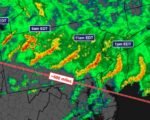Colorado Parks and Wildlife (CPW) has released a new map showing the movement of the 12 collared gray wolves in the state, revealing that they have explored further into the northwestern and central regions of Colorado in the past month.
Wolves cross the continental divide
According to the map, which uses GPS data collected from the collars, the wolves have crossed the continental divide and entered 23 different watersheds between Jan. 23 and Feb. 27, 2024. The map also shows that two wolves have traveled from western Routt County to eastern Moffat County, reaching the northwestern-most county in Colorado. This is the first time that wolves have been confirmed in Moffat County since their reintroduction in 2023.
CPW officials said that the map is intended to provide general information about the wolves’ range and activity, and not to pinpoint their exact locations. The agency also said that the map does not include any uncollared wolves that may be in the state, as they are difficult to detect and monitor.
Wolves pose challenges and opportunities for Colorado
The presence of wolves in Colorado has sparked mixed reactions from different stakeholders, including ranchers, conservationists, hunters, and recreationists. Some ranchers have expressed concern about the potential impact of wolves on their livestock and livelihood, and have asked for more resources and guidance from CPW on how to protect their animals. CPW has released a wolf resource guide that outlines various methods of deterring wolves from livestock, such as fencing, fladry, guard dogs, and hazing.

On the other hand, some conservationists have welcomed the return of wolves to Colorado, arguing that they are an essential part of the ecosystem and can help restore the balance of nature. They have also advocated for more public education and awareness about the benefits and challenges of coexisting with wolves. CPW has also published a guide on living in wolf country that provides tips and best practices for people who may encounter wolves in the wild, such as keeping a safe distance, making noise, and carrying pepper spray.
Wolves face uncertain future in Colorado
The future of wolves in Colorado is still uncertain, as the state is in the process of developing a comprehensive wolf management plan that will address various issues and concerns related to their conservation and management. The plan is expected to be completed by the end of 2024, and will be informed by scientific research, public input, and stakeholder engagement. CPW has established a wolf management webpage that provides updates and information on the plan and the status of wolves in the state.
Meanwhile, the legal status of wolves in Colorado is also unclear, as they are currently protected under the federal Endangered Species Act, but may be delisted in the near future. The U.S. Fish and Wildlife Service announced in 2020 that it would remove gray wolves from the list of endangered and threatened species, but the decision has been challenged in court by several environmental groups. If the delisting is upheld, the management authority of wolves will be transferred from the federal government to the state government, which may have different policies and regulations regarding their protection and hunting.













